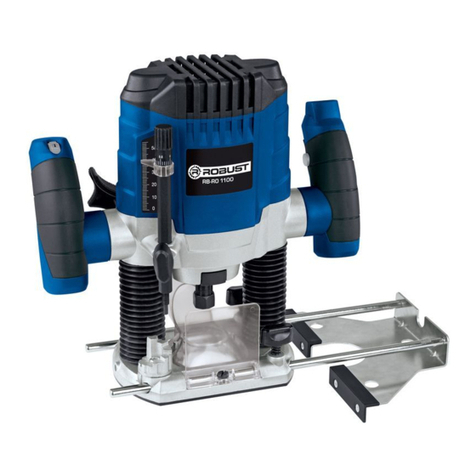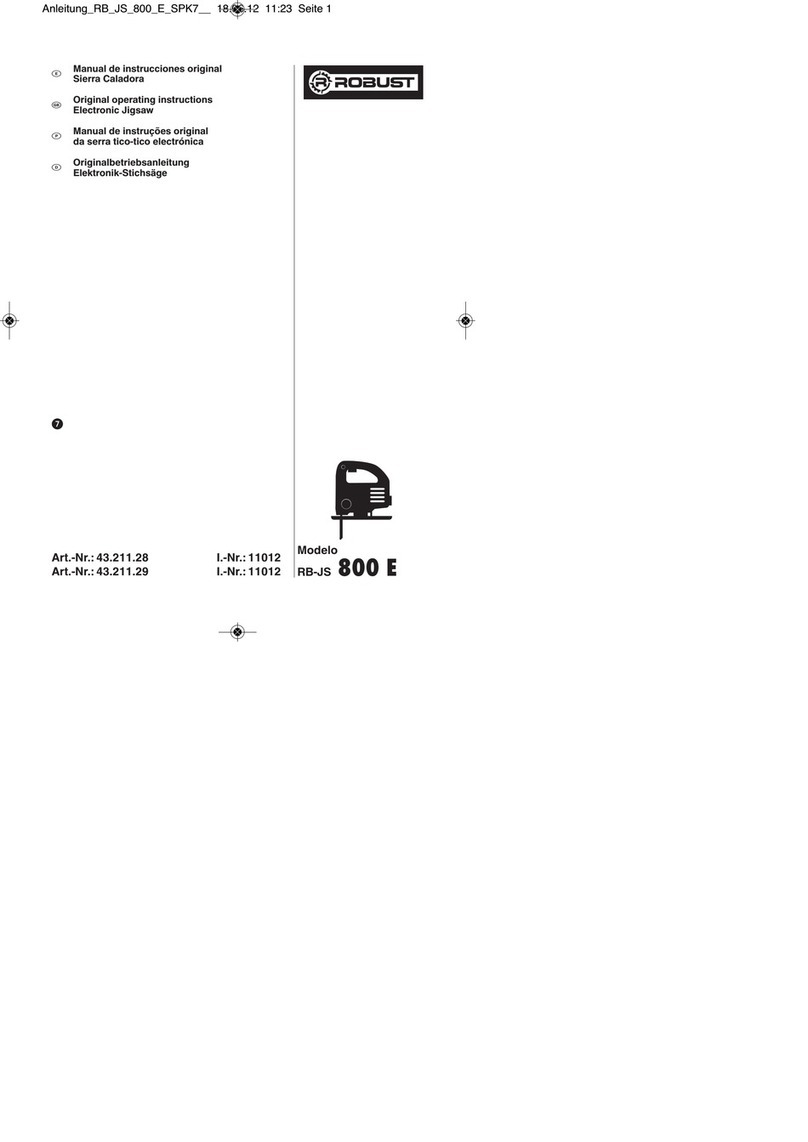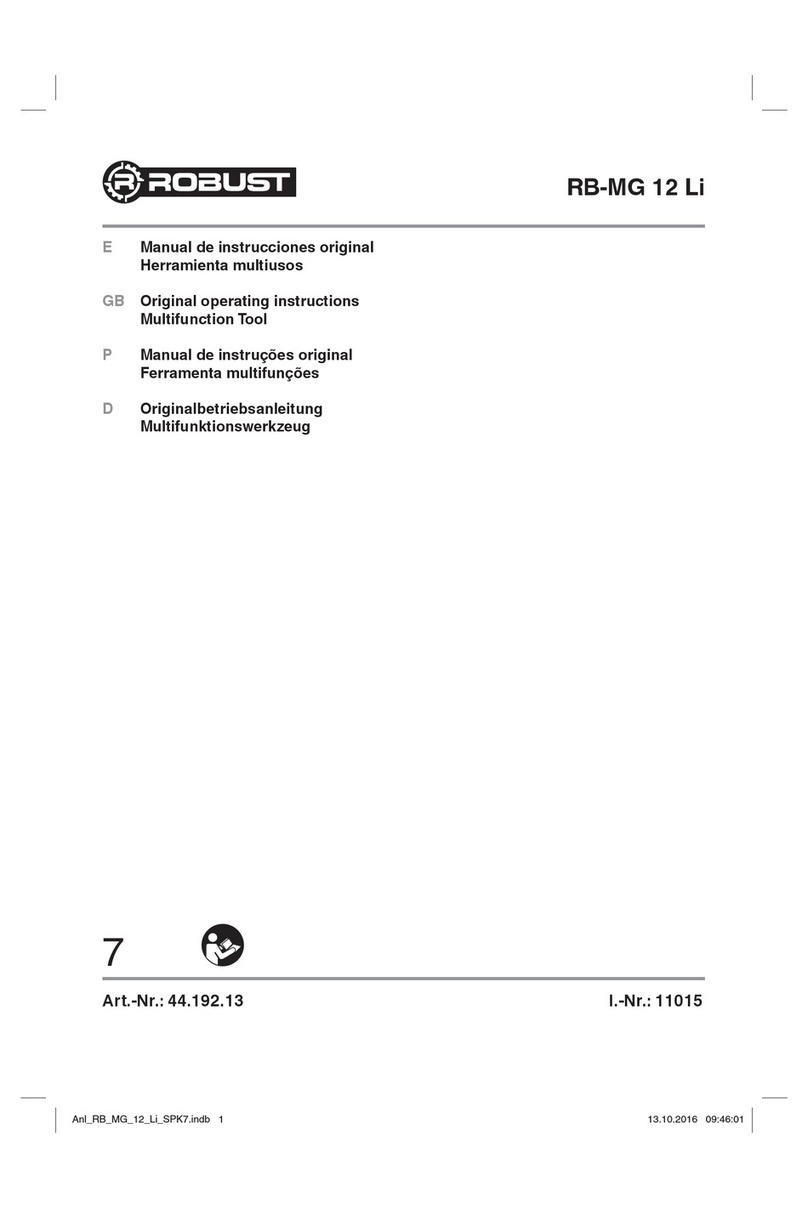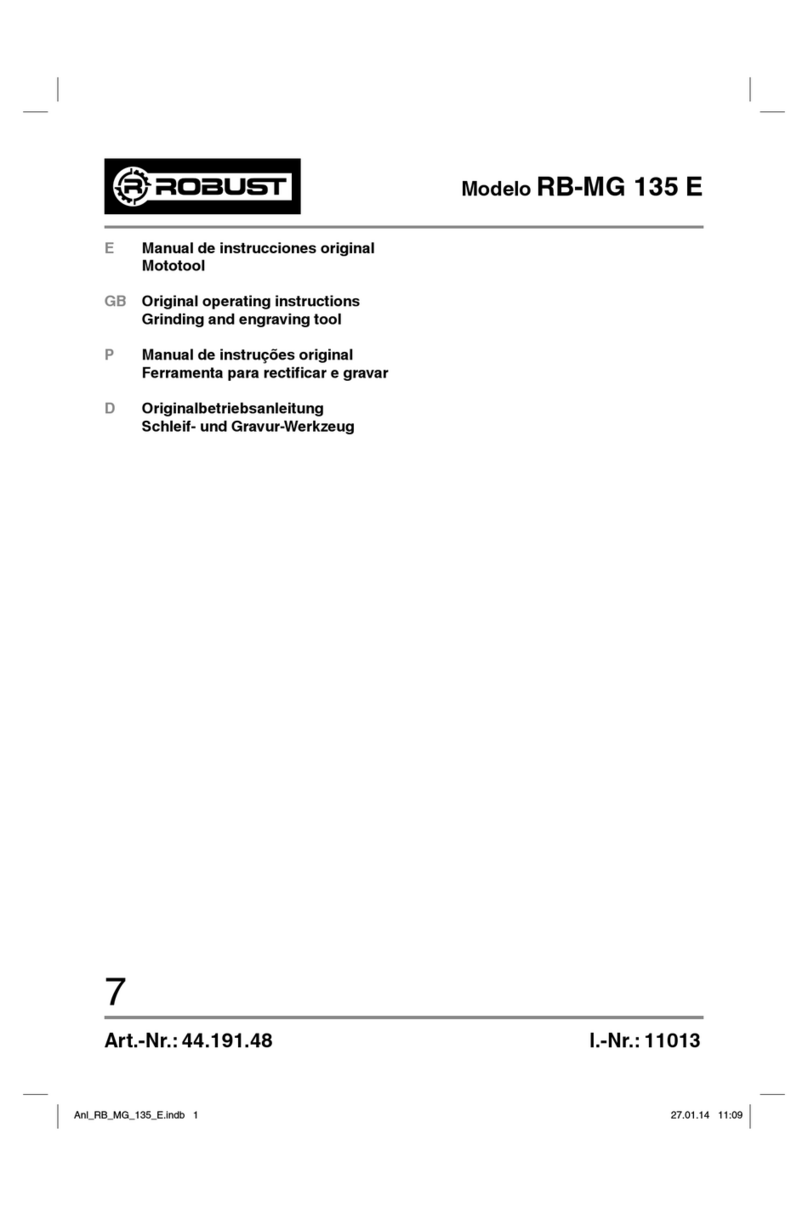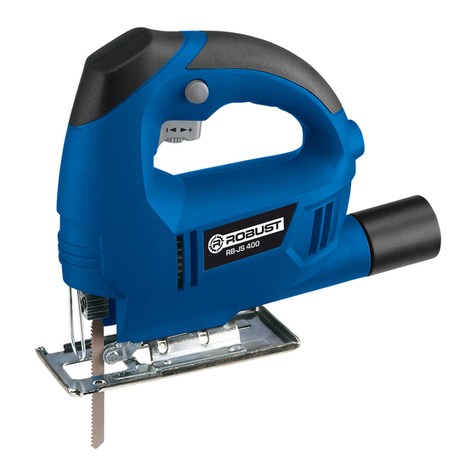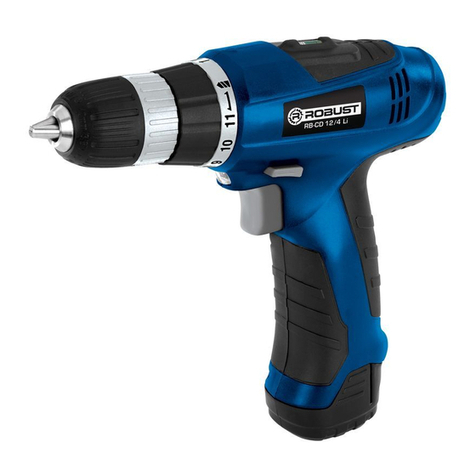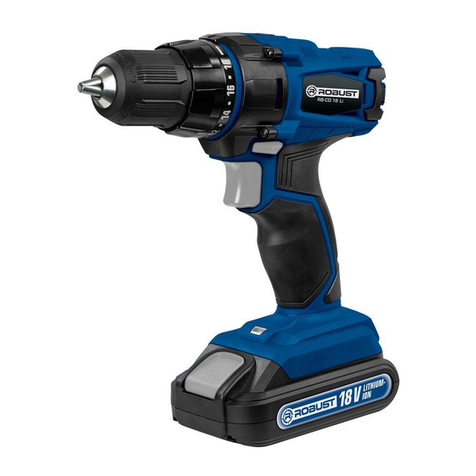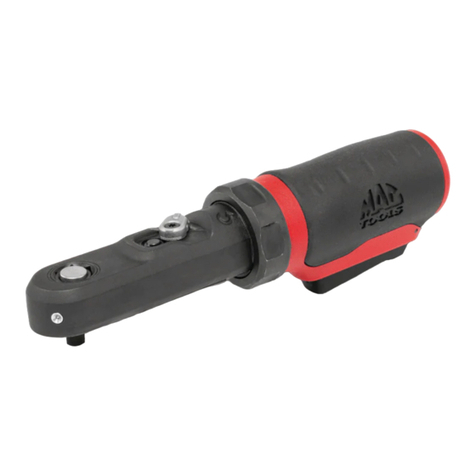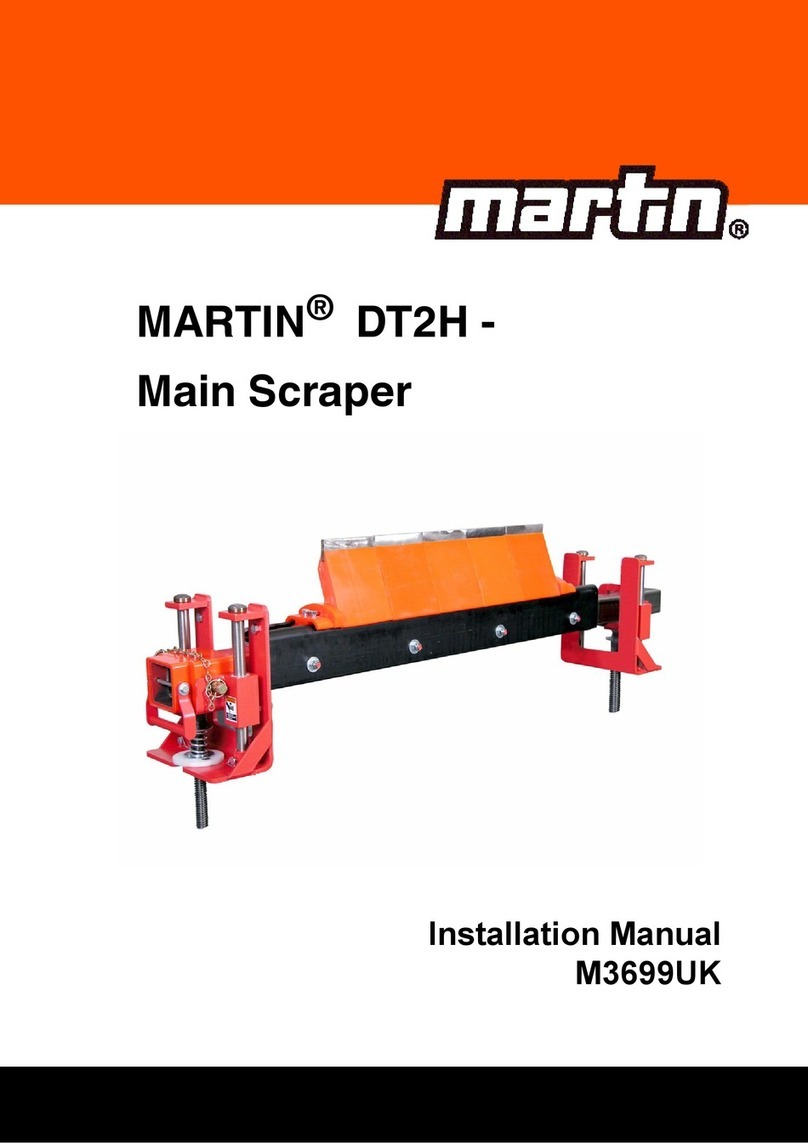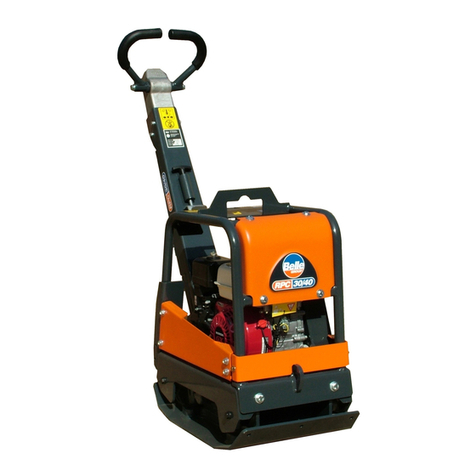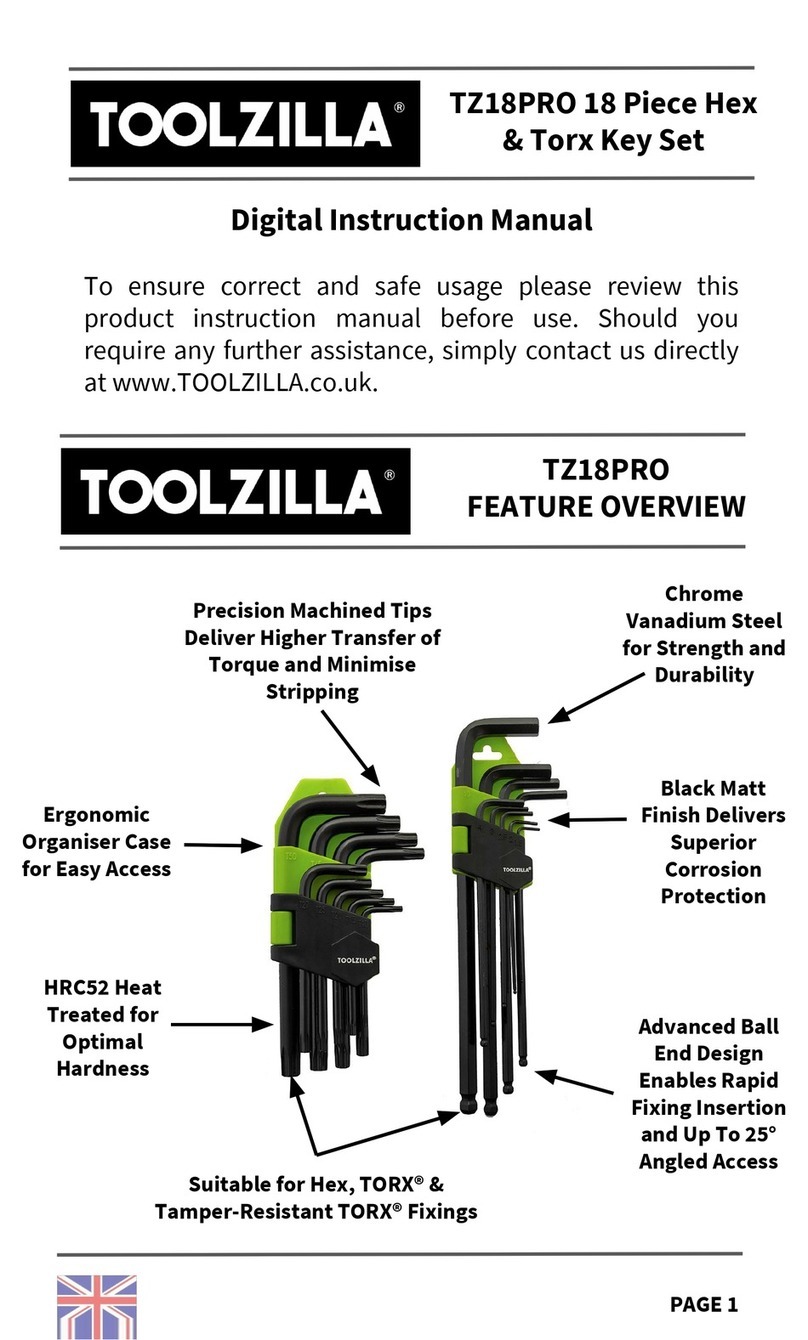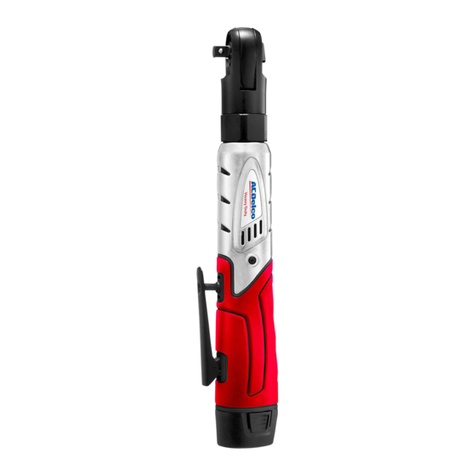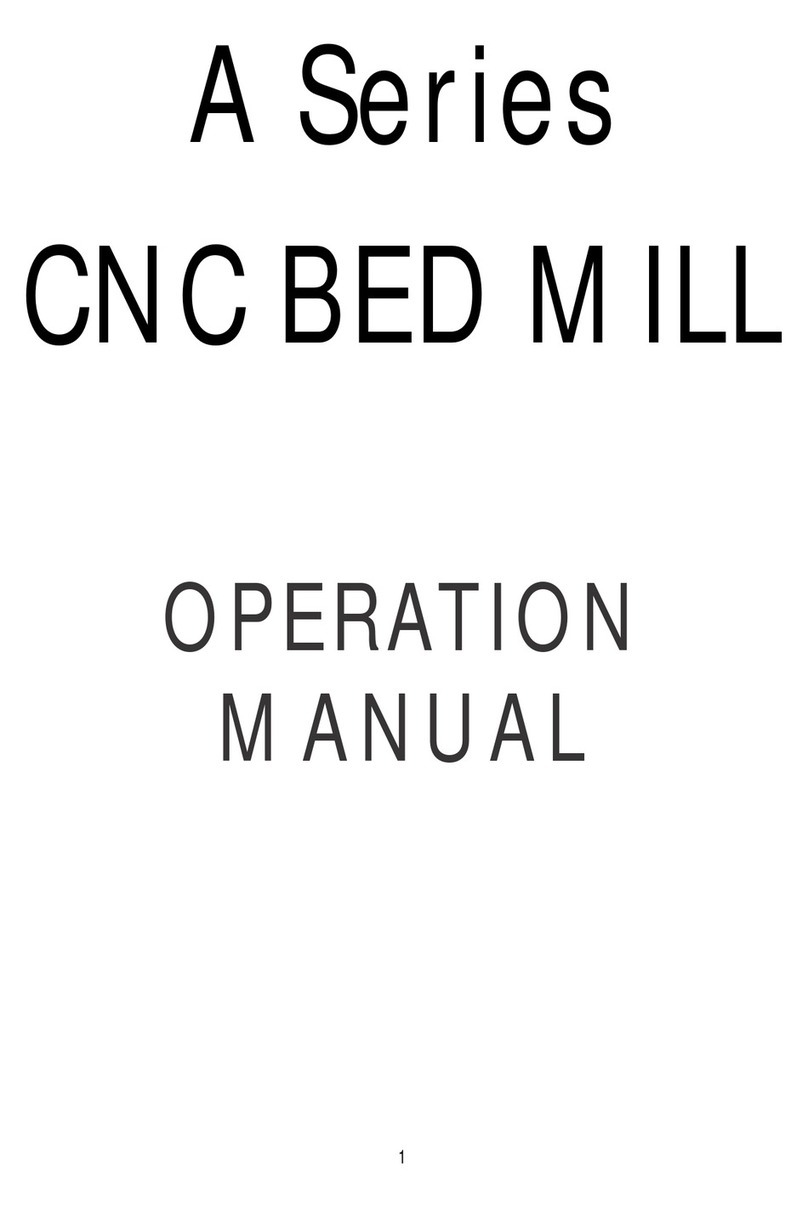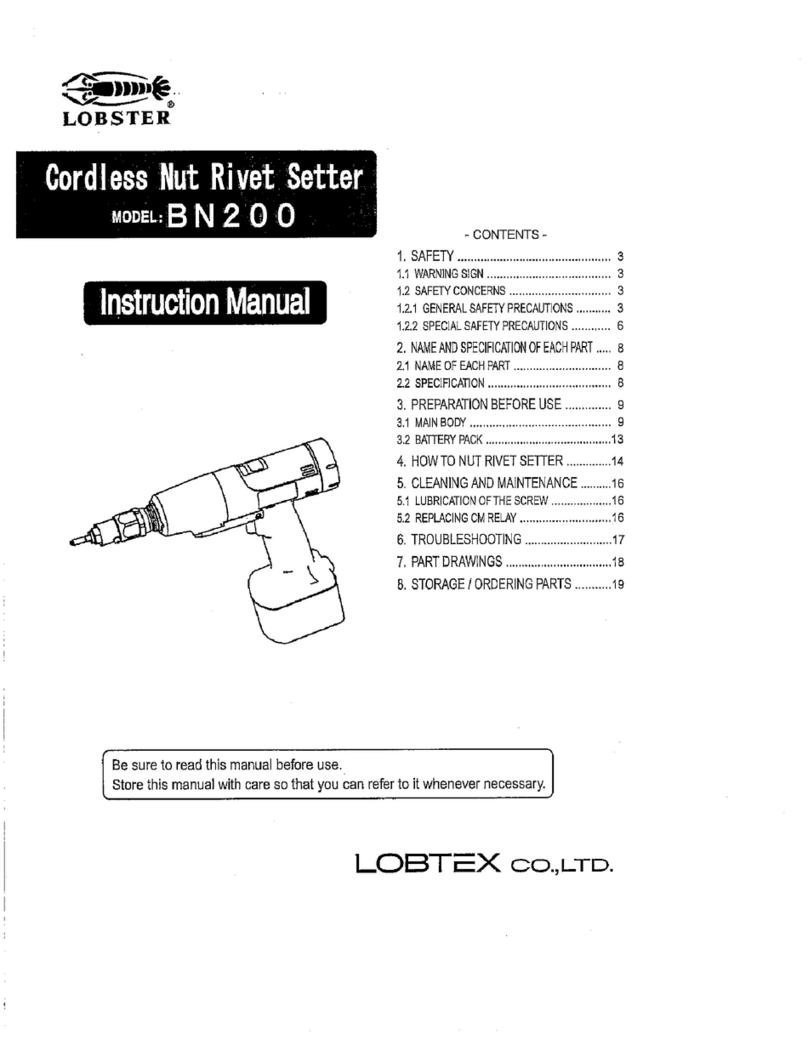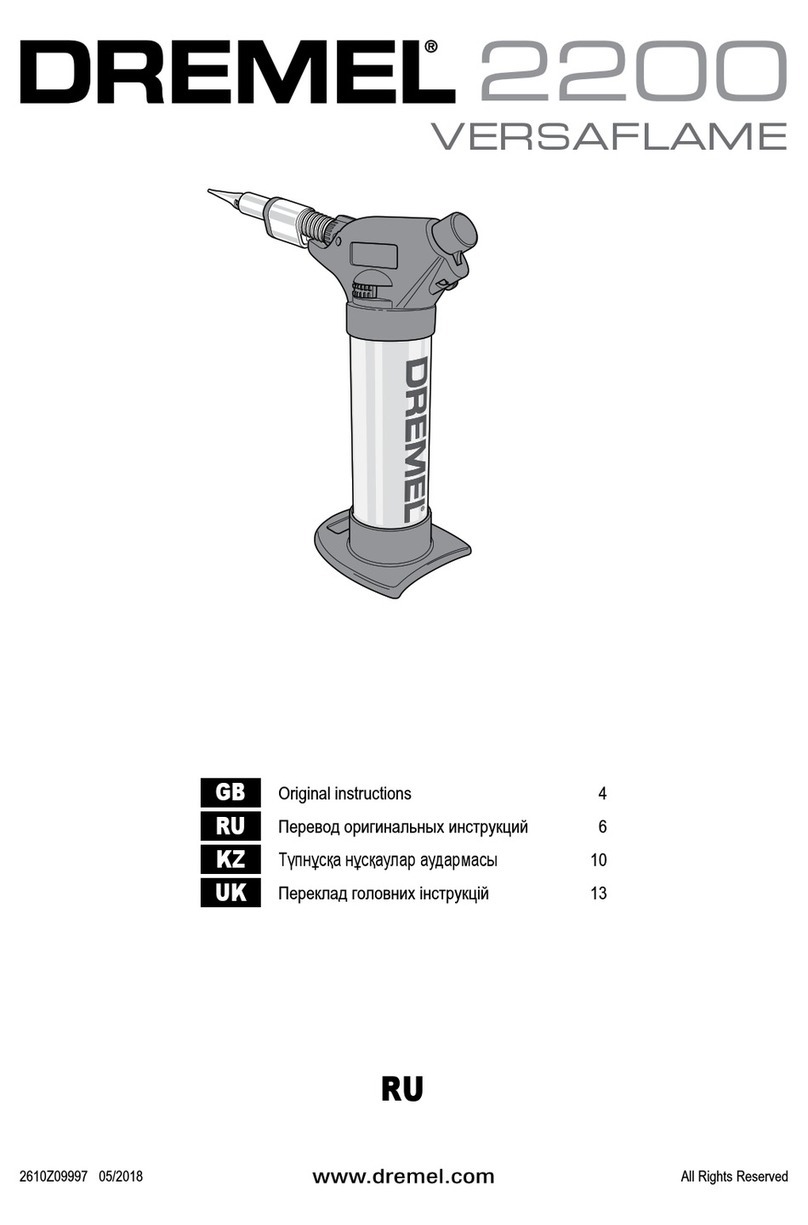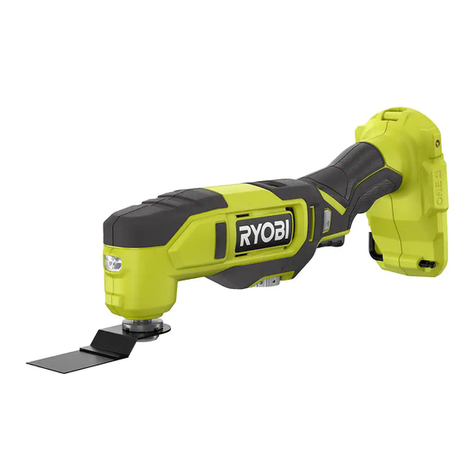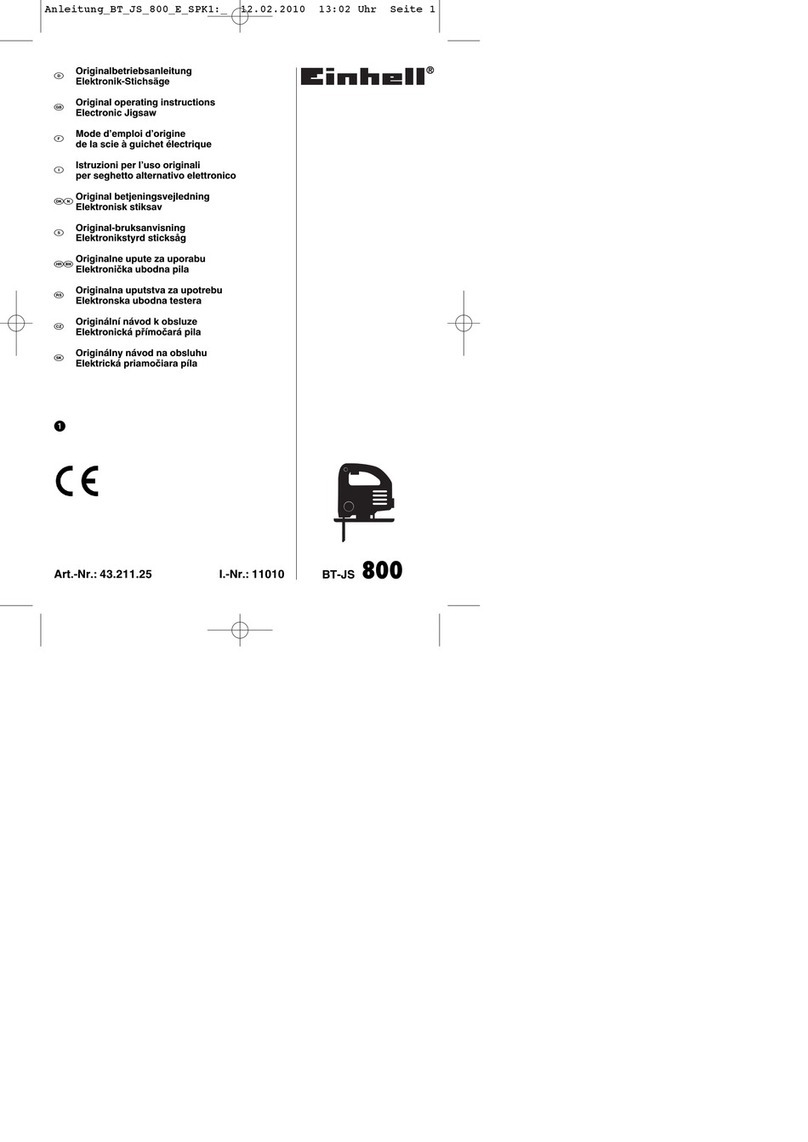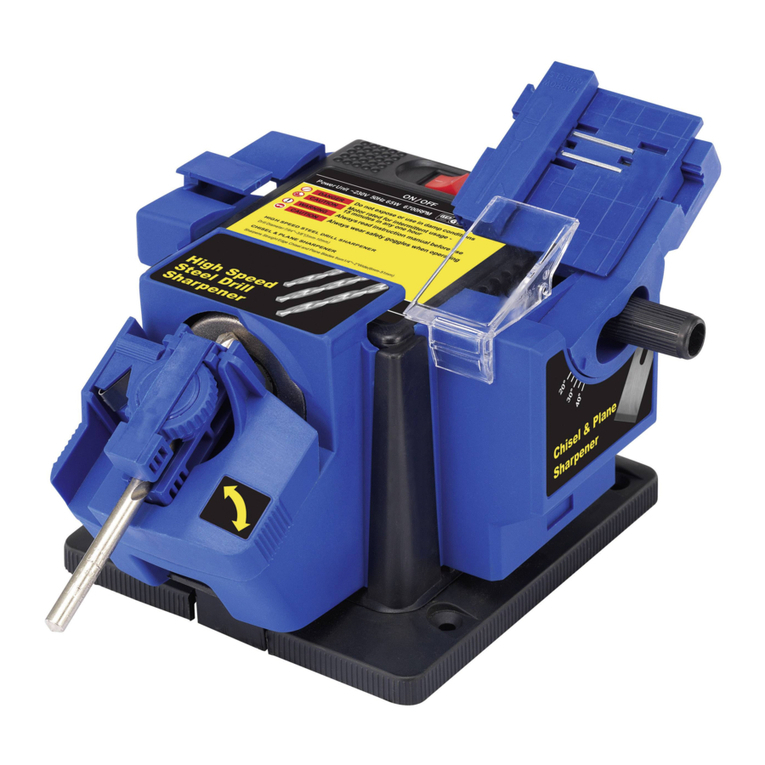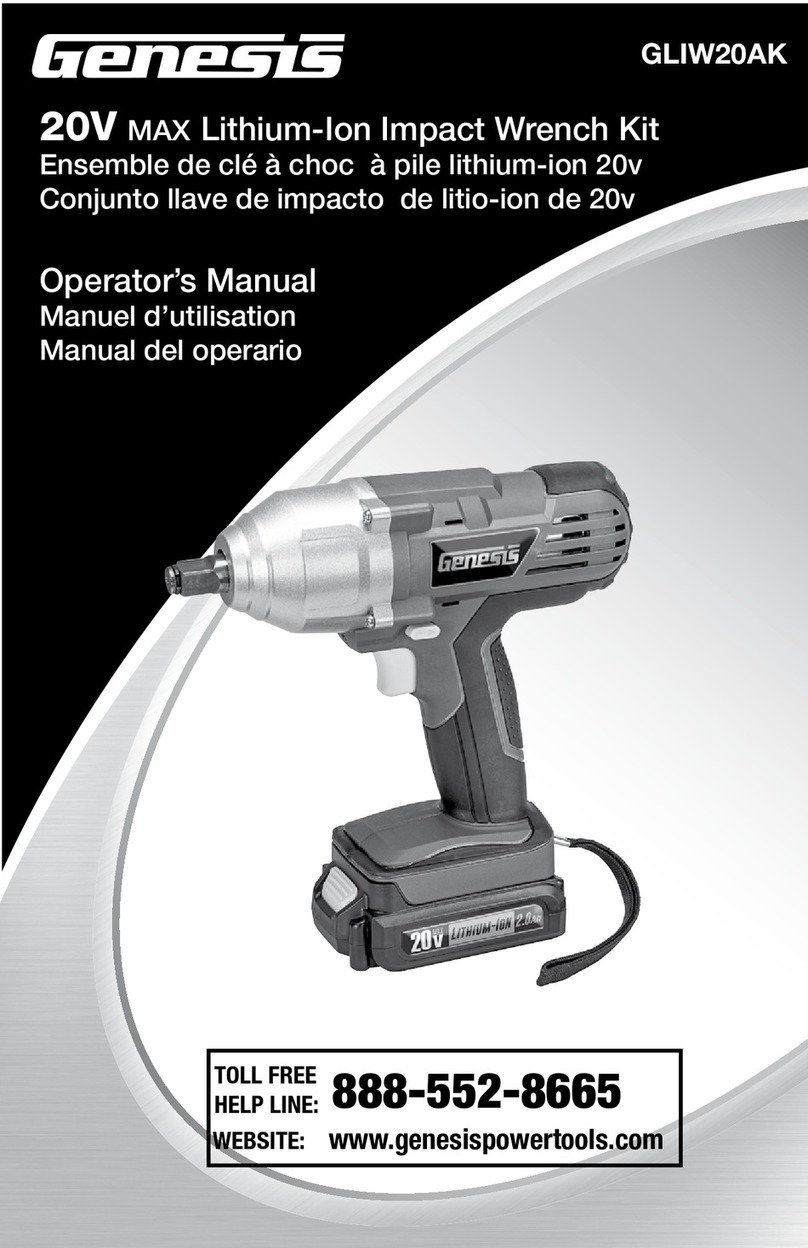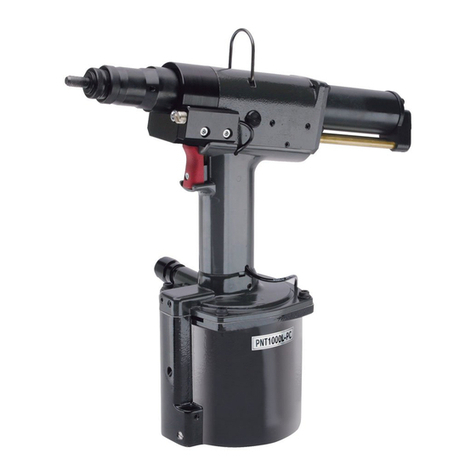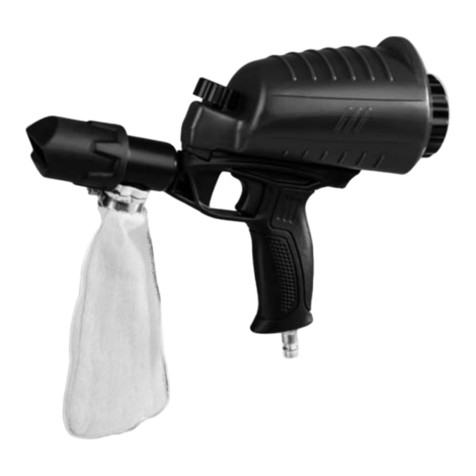Robust RB-CD 12 Li User manual

RB-CD 12 Li
Art.-Nr.: 45.125.43 I.-Nr.: 11015
7
EManual de instrucciones original
Taladro inalambrico
GB Original operating instructions
Cordless drill/screwdriver
PManual de instruções original
Berbequim-aparafusador sem fio
DOriginalbetriebsanleitung
Akku-Bohrschrauber
Anl_RB_CD_12_Li_SPK7.indb 1Anl_RB_CD_12_Li_SPK7.indb 1 11.08.15 14:4911.08.15 14:49

- 2 -
1
2
4
2 1
3
5
8
8
7
a
67
3
5
5
Anl_RB_CD_12_Li_SPK7.indb 2Anl_RB_CD_12_Li_SPK7.indb 2 11.08.15 14:4911.08.15 14:49

- 3 -
4 5
6
4
2a
3
1
Anl_RB_CD_12_Li_SPK7.indb 3Anl_RB_CD_12_Li_SPK7.indb 3 11.08.15 14:4911.08.15 14:49

E
- 4 -
Peligro! - Leer el manual de instrucciones para reducir cualquier riesgo de sufrir daños
Cuidado! Usar protección para los oídos. La exposición al ruido puede ser perjudicial para el oído.
Usar! Llevar gafas de protección. Durante el trabajo, la expulsión de chispas, astillas, virutas y polvo
por el aparato pueden provocar pérdida de vista.
Cuidado! Es preciso ponerse una mascarilla de protección. Puede generarse polvo dañino para la
salud cuando se realicen trabajos en madera o en otros materiales. ¡Está prohibido trabajar con materi-
al que contenga asbesto!
Anl_RB_CD_12_Li_SPK7.indb 4Anl_RB_CD_12_Li_SPK7.indb 4 11.08.15 14:4911.08.15 14:49

E
- 5 -
Peligro!
Al usar aparatos es preciso tener en cuenta una
serie de medidas de seguridad para evitar le-
siones o daños. Por este motivo, es preciso leer
atentamente este manual de instrucciones/adver-
tencias de seguridad. Guardar esta información
cuidadosamente para poder consultarla en cual-
quier momento. En caso de entregar el aparato
a terceras personas, será preciso entregarles,
asimismo, el manual de instrucciones/advertenci-
as de seguridad. No nos hacemos responsables
de accidentes o daños provocados por no tener
en cuenta este manual y las instrucciones de
seguridad.
1. Instrucciones de seguridad
Encontrará las instrucciones de seguridad corres-
pondientes en el prospecto adjunto.
Peligro!
Lea todas las instrucciones de seguridad e
indicaciones. El incumplimiento de dichas inst-
rucciones e indicaciones puede provocar descar-
gas, incendios y/o daños graves. Guarde todas
las instrucciones de seguridad e indicacio-
nes para posibles consultas posteriores.
Instrucciones generales de seguridad para
herramientas eléctricas
Peligro!
Lea todas las instrucciones de seguridad e
indicaciones. El incumplimiento de dichas inst-
rucciones e indicaciones puede provocar descar-
gas, incendios y/o daños graves. Guarde todas
las instrucciones de seguridad e indicacio-
nes para posibles consultas posteriores.
El término de “herramienta eléctrica” que se usa
en las instrucciones de seguridad se refiere a las
herramientas que funcionan en red (con cable de
conexión) y con batería (sin cable de conexión).
1. Seguridad en el lugar de trabajo
a) Mantener limpia y bien iluminada la zona
de trabajo. Las zonas de trabajo desordena-
das o sin luz pueden conllevar accidentes.
b) No trabajar con este aparato eléctrico en
un entorno explosivo en el que se hallen
líquidos, gases o polvos inflamables. Las
herramientas eléctricas generan chispas que
pueden inflamar el polvo o los vapores.
c) Mantener alejados a niños y a otras per-
sonas fuera del alcance de la herramienta
eléctrica. Las distracciones pueden hacer
perder el control sobre el aparato.
2. Seguridad eléctrica
a) El enchufe del aparato eléctrico debe ser
el adecuado para la toma de corriente.
El enchufe no debe ser modificado de
ningún modo. No emplear adaptadores
de enchufe con aparatos eléctricos pu-
estos a tierra. Los enchufes sin modificar y
las tomas de corriente adecuadas reducen el
riesgo de una descarga eléctrica.
b) Evitar el contacto corporal con superfi-
cies con toma de tierra como tubos, ca-
lefacciones, fogones y frigoríficos. Existe
un gran riesgo de descarga eléctrica si su
cuerpo se halla puesto a tierra.
c) Mantener los aparatos eléctricos alejados
de la lluvia o la humedad. Si entra agua en
el aparato eléctrico existirá mayor riesgo de
una descarga eléctrica.
d) No utilizar el cable de forma inadecuada,
no utilizarlo para transportar el aparato,
colgarlo o retirarlo de la toma de corri-
ente. Mantener el cable alejado del calor,
aceites, cantos afilados o partes del apa-
rato en movimiento. Los cables dañados o
mal enrollados aumentan el riesgo de descar-
ga eléctrica.
e) Si se trabaja con una herramienta eléctri-
ca al aire libre, emplear sólo alargaderas
que también sean adecuadas para el
exterior. El empleo de una alargadera apro-
piada para trabajos en el exterior reduce el
riesgo de descarga eléctrica.
f) Si no se puede evitar tener que utilizar la
herramienta eléctrica en un entorno húm-
edo, utilizar un dispositivo de protección
diferencial. El uso de un dispositivo de pro-
tección diferencial reduce el riesgo de sufrir
una descarga eléctrica.
3. Seguridad de personas
a) Prestar atención al trabajo, comprobar
lo que se está haciendo y proceder de
forma razonable durante el trabajo de
una herramienta eléctrica. No emplear la
herramienta eléctrica si se está cansado
o bajo la influencia de drogas, alcohol o
medicamentos. Una mínima falta de atenci-
ón durante el uso de la herramienta eléctrica
puede causar lesiones graves.
b) Llevar equipamiento de protección perso-
nal y siempre unas gafas protectoras. El
Anl_RB_CD_12_Li_SPK7.indb 5Anl_RB_CD_12_Li_SPK7.indb 5 11.08.15 14:4911.08.15 14:49

E
- 6 -
hecho de llevar equipamiento de protección
personal como mascarilla, calzado de segu-
ridad antideslizante, casco de protección o
protección para los oídos, según el tipo y uso
de la herramienta eléctrica, reduce el riesgo
de sufrir lesiones.
c) Evitar una puesta en marcha no intencio-
nada. Asegurarse de que la herramienta
está desconectada antes de enchufarla
a la red eléctrica y/o a la batería, tomarla
en la mano o transportarla. Peligro de sufrir
accidentes si la herramienta eléctrica se tras-
lada pulsando el interruptor o si se enchufa a
la toma de corriente cuando está encendida.
d) Retirar las herramientas de ajuste o la
llave antes de conectar la herramienta
eléctrica. Una herramienta o llave que se
haya olvidado en partes giratorias del aparato
puede producir lesiones.
e) Evitar trabajar en una posición corporal
inadecuada. Adoptar una posición segura
y mantener en todo momento el equilib-
rio. Ello permite controlar mejor la herramien-
ta eléctrica en situaciones inesperadas.
f) Llevar ropa de trabajo adecuada. No
llevar ropa holgada ni joyas durante el
trabajo. Mantener el cabello, la ropa y
los guantes alejados de las piezas en
movimiento. La ropa holgada, las joyas o los
cabellos largos pueden ser atrapados por las
piezas en movimiento.
g) Si el aparato permite instalar dispositi-
vos de aspiración y recogida del polvo,
es preciso asegurarse de que estén
conectados y se empleen de forma cor-
recta. La utilización de un aspirador de polvo
puede reducir los peligros provocados por el
mismo.
4. Empleo y tratamiento de la herramienta
eléctrica
a) No sobrecargar el aparato. Usar la herra-
mienta eléctrica específica para cada tra-
bajo. Con la herramienta eléctrica adecuada
se trabaja mejor y con más seguridad per-
maneciendo dentro de la potencia indicada.
b) No usar ninguna herramienta eléctrica
cuyo interruptor esté defectuoso. Una her-
ramienta eléctrica que ya no pueda conectar-
se o desconectarse conlleva peligros y debe
repararse.
c) Desenchufar el cable de la toma de corri-
ente y/o retirar la batería antes de ajustar
el aparato, cambiar accesorios o abando-
nar el aparato. Esta medida de seguridad
evita que la herramienta eléctrica arranque
accidentalmente.
d) Guardar las herramientas eléctricas que
no se usen fuera del alcance de los niños.
No permitir el uso del aparato a perso-
nas que no estén familiarizadas con él o
no hayan leído estas instrucciones. Las
herramientas eléctricas son peligrosas si las
usan personas sin experiencia.
e) Cuidar la herramienta eléctrica de forma
adecuada. Comprobar que las piezas
móviles funcionen de forma correcta y no
se bloqueen, controlar también si existen
piezas rotas o están tan dañadas que
ponen en peligro el funcionamiento de la
herramienta eléctrica. Reparar las piezas
dañadas antes de usar el aparato. Nume-
rosos accidentes se deben a herramientas
eléctricas mal cuidadas.
f) Mantener limpias y afiladas las herrami-
entas de corte. Las herramientas de corte
bien cuidadas con cantos afilados se bloque-
an con menor frecuencia y pueden manejar-
se de forma más sencilla.
g) Respetar estas instrucciones cuando se
desee utilizar la herramienta eléctrica, los
accesorios, piezas de recambio, etc. Para
ello, tener en cuenta las condiciones de
trabajo y la tarea a ejecutar. El uso de her-
ramientas eléctricas para otros fines diferen-
tes a los previstos puede originar situaciones
peligrosas.
5. Empleo y tratamiento de la herramienta
eléctrica
a) Cargar la batería sólo en cargadores
recomendados por el fabricante. Existe el
peligro de incendio si se utiliza un cargador,
indicado sólo para un tipo concreto de ba-
terías, para otro tipo de baterías.
b) Utilizar sólo las baterías indicadas para la
herramienta eléctrica en cuestión. El uso
de otras baterías puede provocar daños y
conllevar peligro de incendio.
c) Mantener cualquier batería que no se
esté utilizando alejada de grapas, mone-
das, llaves, clavos, tornillos u otros ob-
jetos metálicos pequeños que podrían
provocar un puenteo de los contactos. Un
cortocircuito entre los contactos de la batería
puede tener como consecuencia quemadu-
ras o provocar fuego.
d) Si se utiliza incorrectamente podría salir
líquido de la batería. Evitar el contacto
con el líquido. En caso de tocar acciden-
Anl_RB_CD_12_Li_SPK7.indb 6Anl_RB_CD_12_Li_SPK7.indb 6 11.08.15 14:4911.08.15 14:49

E
- 7 -
talmente el líquido, lavar la zona afectada
con agua. Si el líquido penetra en los
ojos, acudir a un médico. El líquido de la
batería puede provocar irritaciones en la piel
o quemaduras.
6. Servicio
a) Sólo especialistas cualificados deben re-
parar la herramienta eléctrica, empleando
para ello únicamente piezas de repuesto
originales. Esta forma de proceder garantiza
la seguridad de la herramienta eléctrica.
Sujetar el aparato por las empuñaduras ais-
ladas cuando se realicen trabajos en los que
el tornillo o la herramienta insertable puedan
topar con cables eléctricos ocultos. El con-
tacto con un cable de corriente puede electrificar
las piezas metálicas del aparato o provocar una
descarga eléctrica.
Instrucciones de seguridad especiales
Con el fin de ofrecerle baterías con la máxima
densidad de energía, larga duración y seguridad,
prestamos el mayor cuidado en su montaje. Las
celdas de la batería disponen de dispositivos
de seguridad de varios niveles. En primer lugar
se asigna el formato a cada celda y se registran
sus características eléctricas. A continuación,
estos datos se utilizan para agrupar las celdas y
crear la mejores baterías. A pesar de todas las
medidas de seguridad, siempre es necesario
tener precaución al utilizar baterías. Para un
funcionamiento seguro es obligatorio tener
en cuenta los siguientes puntos.
¡El funcionamiento seguro sólo está garantiz-
ado si las celdas no están dañadas! Un ma-
nejo inadecuado puede dañas las celdas.
¡Atención! Los análisis confirman que un uso y
un cuidado inadecuados son la principal causa
de los daños provocados por baterías de alta
potencia.
Advertencias sobre la batería
1. La batería del aparato no se suministra car-
gada. Antes de la primera puesta en marcha,
es preciso recargarla por completo.
2. ¡Para que la batería trabaje de forma óptima
evitar ciclos de descarga prolongados! Re-
cargar la batería con frecuencia.
3. Guardar la batería en un lugar fresco, lo ideal
son 15°C, y como mínimo cargada al 40%.
4. Las baterías de iones de litio están sujetas
a un desgaste natural. ¡La batería debe ser
sustituida como muy tarde cuando su ren-
dimiento sea menor al 80% respecto a su
estado cuando era nueva! Las celdas dete-
rioradas de un conjunto de baterías enveje-
cido no cumplen con los altos requisitos de
rendimiento, representando un riesgo para la
seguridad.
5. No tirar las baterías usadas al fuego. ¡Peligro
de explosión!
6. No prender la batería ni exponerla al fuego.
7. ¡Evitar una descarga total de las baterías!
Este tipo de descarga daña las celdas de la
batería. La causa más frecuente de la descar-
ga total de la batería es el largo almacena-
miento o la no utilización de baterías parcial-
mente descargadas.Terminar el trabajo en
cuanto se aprecie que la potencia disminuye
o se activa el sistema electrónico de protec-
ción. Almacenar la batería sólo tras haberla
cargado completamente.
8. ¡Proteger las baterías y el aparato contra
sobrecarga! La sobrecarga conduce rápida-
mente a un sobrecalentamiento y daño de las
celdas del interior de la carcasa de batería,
sin que el sobrecalentamiento se perciba ex-
ternamente.
9. ¡Evitar daños y golpes! Sustituir inmedia-
tamente las baterías que hayan caído desde
una altura superior a un metro o que hayan
sufrido golpes fuertes, incluso aunque la
carcasa de la batería no parezca dañada.
Las celdas que se encuentren en su interior
podrían estar gravemente dañadas.Tener en
cuenta también las indicaciones de eliminaci-
ón.
10. En caso de sobrecarga y sobrecalentamien-
to, el circuito de protección integrado descon-
ecta el aparato por motivos de seguridad.
¡Atención! Dejar de pulsar el interruptor On/
Offcuando el circuito de protección haya
desconectado el aparato. Podría dañar la ba-
tería.
11. Utilizar exclusivamente baterías originales. El
uso de otras baterías puede provocar daños,
así como explosión y peligro de incendio.
Advertencias sobre el cargador y el proceso
de carga
1. Observar los datos indicados en la placa de
identificación del cargador. Conectar el car-
gador sólo a la tensión nominal indicada en la
placa de características.
2. Proteger el cargador y el cable de daños y
cantos afilados. Los cables dañados deben
ser cambiados exclusivamente por un electri-
cista profesional.
Anl_RB_CD_12_Li_SPK7.indb 7Anl_RB_CD_12_Li_SPK7.indb 7 11.08.15 14:4911.08.15 14:49

E
- 8 -
3. Mantener el cargador, las baterías y el apara-
to fuera del alcance de niños.
4. No emplear cargadores dañados.
5. No emplear el cargador suministrado para
cargar otros aparatos a batería.
6. La batería se calienta bajo condiciones ext-
remas de aplicación. Dejar que la batería se
enfríe hasta alcanzar la temperatura ambien-
tal antes de empezar a cargar.
7. ¡No cargar demasiado las baterías!
Respetar los tiempos de carga máximos.
Estos tiempos de carga se aplican única-
mente a baterías descargadas. Si una batería
cargada o parcialmente cargada se conecta
varias veces al cargador se produce una sob-
recarga y un daño de las celdas. No dejar las
baterías varios días en el cargador.
8. No utilizar ni cargar nunca baterías si se
tiene la sospecha de que la última carga
de la batería puede haberse realizado
hace más de 12 meses. Existe una alta
probabilidad de que la batería ya esté grave-
mente dañada (descarga total).
9. Cargar la batería a una temperatura de me-
nos de 10°C provoca daños químicos en las
celdas y puede conllevar peligro de incendio.
10. No utilizar baterías que se hayan calentado
durante la carga, ya que sus celdas podrían
dañarse peligrosamente.
11. Dejar de usar baterías que se hayan deforma-
do o abombado durante la carga, o aquellas
que presenten síntomas inusuales (despren-
dimiento de gases, zumbidos, chasquidos,...)
12. No descargar la batería por completo (nivel
de descarga recomendado: máx. 80%). La
descarga total provoca un envejecimiento
prematuro de las celdas de la batería.
13. ¡No cargar nunca las baterías sin supervisión!
Protección contra influencias ambientales
1. Ponerse ropa de trabajo adecuada. Ponerse
gafas de protección.
2. Proteger el aparato y el cargador de la
humedad y la lluvia. Éstas podrían provocar
daños peligrosos en las celdas.
3. No utilizar el aparato y el cargador cerca de
vapores y líquidos inflamables.
4. Utilizar el cargador y el aparato a batería sólo
si están secos y a una temperatura ambiente
de 10-40 °C.
5. No guardar la batería en lugares que puedan
alcanzar una temperatura superior a 40 °C,
especialmente no en un vehículo aparcado al
sol.
6. ¡Proteger las baterías contra un sobreca-
lentamiento! La sobrecarga, carga excesiva
o la radiación solar conducen a un sobre-
calentamiento y al daño de las celdas. No
cargar ni trabajar en ningún caso con baterías
que se hayan sobrecalentado. Sustituirlas
inmediatamente.
7. Almacenamiento de baterías, cargadores
y del aparato. Guardar siempre el cargador
y el aparato en habitaciones secas con una
temperatura ambiente de 10-40°C. Guardar
la batería de iones de litio en un lugar fresco
y seco a 10-20°C. ¡Proteger de la humedad
ambiental y de la radiación solar! Guardar las
baterías únicamente cuando estén cargadas
(mín. al 40%).
8. Evitar que la batería de iones de litio se hie-
len. Deshacerse de las baterías que hayan
estado guardadas a 0°C durante más de 60
minutos.
9. Llevar cuidado con la carga electrostática al
manipular baterías: las descargas electros-
táticas provocan daños en el sistema electró-
nico de protección y las celdas de la batería.
¡Evitar por ello la carga electrostática y no
tocar nunca los polos de la batería!
Los acumuladores y aparatos eléctricos con ba-
tería contienen materiales que pueden resultar
nocivos para el medio ambiente.No deberá tirar
aparatos con batería a la basura normal.
Para el envío o la eliminación de baterías
o del aparato, estos deben embalarse por
separado en bolsas de plástico para evitar
cortocircuitos o incendios.
Guardar las instrucciones de seguridad en
lugar seguro.
Anl_RB_CD_12_Li_SPK7.indb 8Anl_RB_CD_12_Li_SPK7.indb 8 11.08.15 14:4911.08.15 14:49

E
- 9 -
2. Descripción del aparato y
volumen de entrega
2.1 Descripción del aparato (fig. 1)
1. Ajuste de par (anillo de ajuste)
2. Portabrocas de sujeción rápida
3. Interruptor de inversión de marcha
4. Interruptor On/Off
5. Batería
6. Cargador
7. Adaptador de carga
8. Dispositivo de retención
2.2 Volumen de entrega
Sirviéndose de la descripción del volumen de
entrega, comprobar que el artículo esté completo.
Si faltase alguna pieza, dirigirse a nuestro Ser-
vice Center o a la tienda especializada más cer-
cana en un plazo máximo de 5 días laborales tras
la compra del artículo presentando un recibo de
compra válido. A este respeto, observar la tabla
de garantía de las condiciones de garantía que se
encuentran al final del manual.
• Abrir el embalaje y extraer cuidadosamente
el aparato.
• Retirar el material de embalaje, así como los
dispositivos de seguridad del embalaje y para
el transporte (si existen).
• Comprobar que el volumen de entrega esté
completo.
• Comprobar que el aparato y los accesorios
no presenten daños ocasionados durante el
transporte.
• Si es posible, almacenar el embalaje hasta
que transcurra el periodo de garantía.
Peligro!
¡El aparato y el material de embalaje no son
un juguete! ¡No permitir que los niños jue-
guen con bolsas de plástico, láminas y pie-
zas pequeñas! ¡Riesgo de ingestión y asfixia!
• Taladro atornillador con batería
• Batería
• Cargador
• Adaptador de carga
• Manual de instrucciones original
3. Uso adecuado
El taladro atornillador con batería está diseñado
para atornillar y desatornillar tornillos, así como
para taladrar en madera, metal y plástico.
Utilizar la máquina sólo en los casos que se indi-
can explícitamente como de uso adecuado. Cual-
quier otro uso no será adecuado. En caso de uso
inadecuado, el fabricante no se hace responsable
de daños o lesiones de cualquier tipo; el respon-
sable es el usuario u operario de la máquina.
Tener en consideración que nuestro aparato no
está indicado para un uso comercial, industrial o
en taller. No asumiremos ningún tipo de garantía
cuando se utilice el aparato en zonas industria-
les, comerciales o talleres, así como actividades
similares.
4. Características técnicas
Alimentación de tensión motor................12 V c.c.
Velocidad marcha en vacío: ............... 0-710 r.p.m
Niveles de par de giro: ................................ 20+1
Giro derecha-izquierda .....................................sí
Diámetro de sujeción portabrocas: . máx. 10 mm
Tensión de carga batería: .......................15 V c.c.
Corriente de carga de la batería:............... 0,5 mA
Tensión de red del cargador .......... 230 V ~ 50 Hz
Tiempo de carga: ..............................máx. 3-5 h
Tipo de batería: .......................................... Li-Ion
Peso: ..........................................................1,0 kg
Peligro!
Ruido y vibración
Los valores con respecto al ruido y la vibración se
determinaron conforme a la norma EN 60745.
Nivel de presión acústica LpA ................. 62 dB(A)
Imprecisión KpA ............................................3 dB
Nivel de potencia acústica LWA .............. 73 dB(A)
Imprecisión KWA ............................................3 dB
Usar protección para los oídos.
La exposición al ruido puede ser perjudicial para
el oído.
Los valores totales de vibración (suma de vec-
tores en las tres direcciones) se determinaron
conforme a la norma EN 60745.
Anl_RB_CD_12_Li_SPK7.indb 9Anl_RB_CD_12_Li_SPK7.indb 9 11.08.15 14:4911.08.15 14:49

E
- 10 -
Taladrado en metal
Valor de emisión de vibraciones ah≤2,5 m/s2
Imprecisión K = 1,5 m/s2
Atornillado sin percusión
Valor de emisión de vibraciones ah≤2,5 m/s2
Imprecisión K = 1,5 m/s2
El valor de emisión de vibraciones indicado se
ha calculado conforme a un método de ensayo
normalizado, pudiendo, en algunos casos excep-
cionales, variar o superar el valor indicado depen-
diendo de las circunstancias en las que se utilice
la herramienta eléctrica.
El valor de emisión de vibraciones indicado pue-
de utilizarse para comparar la herramienta con
otras.
El valor de emisión de vibraciones indicado tam-
bién puede utilizarse para una valoración prelimi-
nar de los riesgos.
¡Reducir la emisión de ruido y las vibracio-
nes al mínimo!
• Emplear sólo aparatos en perfecto estado.
• Realizar el mantenimiento del aparato y limpi-
arlo con regularidad.
• Adaptar el modo de trabajo al aparato.
• No sobrecargar el aparato.
• En caso necesario dejar que se compruebe
el aparato.
• Apagar el aparato cuando no se esté utilizan-
do.
• Usar guantes.
Cuidado!
Riesgos residuales
Incluso si esta herramienta se utiliza adecua-
damente, siempre existen riesgos residuales.
En función de la estructura y del diseño de
esta herramienta eléctrica pueden producir-
se los siguientes riesgos:
1. Lesiones pulmonares en caso de que no se
utilice una mascarilla de protección antipolvo.
2. Lesiones auditivas en caso de que no se utili-
ce una protección para los oídos adecuada.
3. Daños a la salud derivados de las vibracio-
nes de las manos y los brazos si el aparato
se utiliza durante un largo periodo tiempo, no
se sujeta del modo correcto o si no se realiza
un mantenimiento adecuado.
5. Antes de la puesta en marcha
Antes de la puesta en marcha del taladro per-
cutor a batería, es preciso leer las siguientes
advertencias:
1. Cargar la batería exclusivamente con el car-
gador que se suministra adjunto.
2. Utilice únicamente taladros afilados, así
como puntas portatornillo adecuadas.
3. Cuando taladre o atornille paredes y muros,
compruebe que no exista ningún cable de
electricidad o conducto de gas y agua escon-
didos.
6. Manejo
6.1 Carga de la batería (fig. 2-3)
1. Extraer la batería (5) de la empuñadura (fig.
2) presionando los dispositivos de retención
(8) en los laterales izquierdo y derecho de la
batería (5 ).
2. Comprobar que la tensión de red coincida
con la especificada en la placa de identifica-
ción del aparato.
3. Enchufar el cargador (6) a la toma de cor-
riente y conectar el cable de carga (a) con
el adaptador de carga (7). El LED verde del
adaptador de carga (7) empieza a parpadear.
4. Acoplar la batería (5) al adaptador de carga.
El LED rojo indica que la batería se está car-
gando.
5. Una vez finalizado el proceso de carga trans-
curridas de 3 a 5 horas, se vuelve a apagar el
LED rojo y el verde se enciende.
Si solo parpadea el LED rojo, significa que la
batería está averiada.Quitar la batería. No se
puede volver a emplear una batería de iones de
litio defectuosa.
Es posible que la batería (5) se caliente durante
el proceso de carga, lo que resulta normal.
En caso que no sea posible cargar la batería,
comprobar que
• exista tensión de red en la toma de corriente.
• exista buen contacto entre los contactos de
carga del cargador.
En caso de que todavía no fuera posible cargar la
batería, rogamos enviar
• el cargador
• y la batería
Anl_RB_CD_12_Li_SPK7.indb 10Anl_RB_CD_12_Li_SPK7.indb 10 11.08.15 14:4911.08.15 14:49

E
- 11 -
a nuestro servicio de asistencia técnica.
Es preciso recargar siempre a tiempo la batería
para procurar que dure lo máximo posible. Esto
es imprescindible en el caso de que note que se
reduce la potencia del talador percutor a batería.
6.2 Ajuste de par (fig. 4/pos. 1)
El atornillador con batería está equipado con un
ajuste de par mecánico.
El par de giro para un tamaño determinado de
tornillos se regula en el anillo de ajuste (1). El par
de giro depende de varios factores:
• del tipo y dureza del material a tratar.
• del tipo y longitud de los tornillos utilizados.
• de las solicitaciones a las que se vea expues-
ta la atornilladura.
Se indicará que se ha alcanzado el par de giro
cuando haga clic el acoplamiento.
¡Atención! Regule el anillo de ajuste para el
par de giro solo cuando la herramienta esté
detenida.
6.3 Taladrar (fig. 4/pos. 1)
Para taladrar, posicionar el anillo de ajuste para
el par en el último nivel „Broca“. En este nivel, el
acoplamiento deslizante está fuera de servicio.
Para taladrar puede utilizarse el par máximo.
6.4 Interruptor de inversión de marcha
(fig. 5/pos. 3)
Con el interruptor deslizante situado sobre el in-
terruptor ON/OFF puede ajustar el sentido de giro
del atornillador con batería y asegurar el atornil-
lador contra una conexión involuntaria. Se puede
elegir entre giro a la izquierda y giro a la derecha.
Con el fin de evitar que se dañe el engranaje, el
sentido de giro sólo se deberá cambiar cuando la
herramienta se haya detenido por completo. Si el
interruptor deslizante se encuentra en la posición
central, el interruptor ON/OFF está bloqueado.
6.5 Interruptor ON/OFF (fig. 5/pos. 4)
Con el interruptor ON/OFF, se puede controlar de
forma continua el número de revoluciones. Cu-
anto más se presione el interruptor, mayor será la
velocidad del taladro.
6.6 Cambio de herramienta (fig. 6)
¡Atención! Al realizar cualquier tipo de trabajo (p.
ej., cambio de herramienta; mantenimiento; etc.)
en el taladro, colocar el interruptor de inversión
de marcha (3) en la posición central.
• Desenroscar el portabrocas (2).
• El orificio del portabrocas (a) debe ser lo sufi-
cientemente grande como para poder alojar
la herramienta (broca o portatornillos).
• Elegir la herramienta adecuada. Introducir la
herramienta al máximo posible en el orificio
del portabrocas (a).
• Girar cerrando bien el portabrocas (2) y
comprobar a continuación que la herramienta
esté correctamente encajada.
6.7 Tornillos
Utilice preferentemente tornillos con autocentraje
(p. ej., Torx, ranura en cruz), puesto que garanti-
zan seguridad en el trabajo. Asegurarse de que
coincida la forma y el tamaño del portatornillos
y del tornillo. Realice el ajuste del par de giro,
según se describe en las instrucciones, conforme
al tamaño de los tornillos.
7. Mantenimiento, limpieza y pedido
de piezas de repuesto
Peligro!
Desenchufar siempre antes de realizar algún tra-
bajo de limpieza.
7.1 Limpieza
• Reducir al máximo posible la suciedad y
el polvo en los dispositivos de seguridad,
las rendijas de ventilación y la carcasa del
motor. Frotar el aparato con un paño limpio o
soplarlo con aire comprimido manteniendo la
presión baja.
• Se recomienda limpiar el aparato tras cada
uso.
• Limpiar el aparato con regularidad con un
paño húmedo y un poco de jabón blando.No
utilizar productos de limpieza o disolventes ya
que se podrían deteriorar las piezas de plá-
stico del aparato. Es preciso tener en cuenta
que no entre agua en el interior del aparato.
Si entra agua en el aparato eléctrico existirá
mayor riesgo de una descarga eléctrica.
7.2 Mantenimiento
No hay que realizar el mantenimiento a más
piezas en el interior del aparato.
Anl_RB_CD_12_Li_SPK7.indb 11Anl_RB_CD_12_Li_SPK7.indb 11 11.08.15 14:4911.08.15 14:49

E
- 12 -
7.3 Pedido de piezas de recambio:
Al solicitar recambios se indicarán los datos si-
guientes:
• Tipo de aparato
• No. de artículo del aparato
• No. de identidad del aparato
• No. del recambio de la pieza necesitada.
8. Eliminación y reciclaje
El aparato está protegido por un embalaje para
evitar daños producidos por el transporte.Este
embalaje es materia prima y, por eso, se puede
volver a utilizar o llevar a un punto de reciclaje. El
aparato y sus accesorios están compuestos de
diversos materiales, como, p. ej., metal y plástico.
Los aparatos defectuosos no deben tirarse a la
basura doméstica. Para su eliminación adecu-
ada, el aparato debe entregarse a una entidad
recolectora prevista para ello.En caso de no
conocer ninguna, será preciso informarse en el
organismo responsable del municipio.
9. Almacenamiento
Guardar el aparato y sus accesorios en un
lugar oscuro, seco, protegido de las heladas e
inaccesible para los niños. La temperatura de
almacenamiento óptima se encuentra entre los
5 y 30 ˚C. Guardar la herramienta eléctrica en su
embalaje original.
Anl_RB_CD_12_Li_SPK7.indb 12Anl_RB_CD_12_Li_SPK7.indb 12 11.08.15 14:4911.08.15 14:49

GB
- 13 -
Danger! - Read the operating instructions to reduce the risk of inquiry
Caution! Wear ear-muffs. The impact of noise can cause damage to hearing.
Caution! Wear safety goggles. Sparks generated during working or splinters, chips and dust emitted
by the device can cause loss of sight.
Caution! Wear a breathing mask. Dust which is injurious to health can be generated when working on
wood and other materials. Never use the device to work on any materials containing asbestos!
Anl_RB_CD_12_Li_SPK7.indb 13Anl_RB_CD_12_Li_SPK7.indb 13 11.08.15 14:4911.08.15 14:49

GB
- 14 -
Danger!
When using the equipment, a few safety pre-
cautions must be observed to avoid injuries and
damage. Please read the complete operating
instructions and safety regulations with due care.
Keep this manual in a safe place, so that the in-
formation is available at all times. If you give the
equipment to any other person, hand over these
operating instructions and safety regulations as
well.We cannot accept any liability for damage
or accidents which arise due to a failure to follow
these instructions and the safety instructions.
1. Safety regulations
The corresponding safety information can be
found in the enclosed booklet.
Danger!
Read all safety regulations and instructions.
Any errors made in following the safety regula-
tions and instructions may result in an electric
shock, fire and/or serious injury.
Keep all safety regulations and instructions
in a safe place for future use.
General safety instructions for electric tools
Danger!
Read all safety regulations and instructions.
Any errors made in following the safety regula-
tions and instructions may result in an electric
shock, fire and/or serious injury.
Keep all safety regulations and instructions
in a safe place for future use.
The term “electric tool” used in the safety inst-
ructions refers to electric tools operated from the
mains power supply (with a power cable) and to
battery operated electric tools (without a power
cable).
1. Workplace safety
a) Keep your work area clean and well illu-
minated. Untidy or unlit work areas can result
in accidents.
b) Do not operate the electric tool in an en-
vironment where there is a risk of explo-
sions and where there are inflammable
liquids, gases or dust. Electric tools produ-
ce sparks which could set the dust or vapours
alight.
c) Keep the electric tool out of the reach of
children and other persons. If there is a
distraction, you may lose control of the appli-
ance.
2. Electrical safety
a) The connector plug from this electric tool
must fit into the socket.The plug should
never be altered in any way. Never use ad-
apter plugs together with earthed electric
tools. Unaltered plugs and correct sockets
reduce the risk of an electric shock.
b) Avoid bodily contact with earthed sur-
faces such as pipes, heating, ovens and
fridges. The risk of electric shock is increa-
sed if your body is earthed.
c) Keep the tool out of the rain and away
from moisture. The ingress of water into an
electric tool increases the risk of an electric
shock.
d) Do not use the cable to carry the electric
tool, to hang it up or to pull it out of the
socket. Keep the cable away from heat,
oil, sharp edges and moving parts of the
appliance. Damaged or entangled cables
increase the risk of an electric shock.
e) If you are working outdoors with an elec-
tric tool, only use extension cables which
are designed specifically for this purpose.
Using specially designed outdoor extension
cables, the risk of electric shock is reduced.
f) If operation of the electric tool in a damp
environment can not be avoided, use a
earth-leakage circuit-breaker. The earth-
leakage circuit-breaker reduces the risk of an
electric shock.
3. Safety of persons
a) Be careful, watch what you are doing and
use an electric tool sensibly. Do not use
the tool if you are tired or under the influ-
ence of drugs, alcohol or medication. A
moment of inattention when using the electric
tool can result in serious injuries.
b) Wear personal protection equipment
and always wear safety goggles. Wearing
personal protection (such as dust masks,
non-slip safety shoes, safety helmet or ear
protection, depending upon the type and use
of the electric tool) reduces the risk of injury.
c) Make sure that the appliance cannot start
up accidentally. Ensure that the electric
tool is switched offbefore you connect
it to the power supply and/or insert the
battery, or pick up or carry the tool. If your
finger is on the switch whilst carrying the elec-
tric tool or if you connect the appliance to the
Anl_RB_CD_12_Li_SPK7.indb 14Anl_RB_CD_12_Li_SPK7.indb 14 11.08.15 14:4911.08.15 14:49

GB
- 15 -
mains when it is switched on, this can lead to
accidents.
d) Remove keys and wrenches before swit-
ching on the electric tool. A tool or key
which comes into contact with rotating parts
of the appliance can lead to injuries.
e) Avoid abnormal working postures. Make
sure you stand squarely and keep your
balance at all times. In this way, you can
control the electric tool better in unexpected
circumstances.
f) Wear suitable work clothes. Do not wear
loose clothing or jewellery. Keep hair, clo-
thes and gloves away from moving parts.
Loose clothing, jewellery or long hair can get
trapped in moving parts.
g) If vacuuming devices and draining de-
vices can be fitted, make sure that these
are correctly attached and correctly used.
The use of a dust extraction system can redu-
ce the danger posed by dust.
4. Usage and treatment of the electric tool
a) Do not overload the appliance. Use the
correct tool for your work. You will be able
to work better and more safely within the gi-
ven performance boundaries.
b) Do not use an electric tool with a defec-
tive switch. An electric tool that cannot be
switched on or offis dangerous and must be
repaired.
c) Pull the plug out of the socket and/or
remove the battery before making any ad-
justments to the appliance, changing ac-
cessories or put the appliance down. This
safety measure prevents starting the electric
tool unintentionally.
d) Keep unused electric tools out of the
reach of children. Do not allow people
who are not familiar with the appliance or
who have not read these instructions to
use the appliance. Electric tools are dange-
rous if they are used by inexperienced people.
e) Clean your electric tool carefully. Check
whether moving parts are functioning
properly and not jamming, whether parts
are broken or damaged enough that the
functioning of this electric tool is affec-
ted. Have damaged parts repaired before
using the appliance. Many accidents are
caused by badly maintained electric tools.
f) Keep your cutting tools sharp and clean.
Carefully maintained cutting tools with sharp
cutting edges will jam less and are easier to
control.
g) Make sure to use electric tools, accesso-
ries, attachments, etc. in accordance with
these instructions. Take the conditions in
your work area and the job in hand into
account. Using electric tools for any purpose
other than the one for which they are intended
can lead to dangerous situations.
5. Using and handling the cordless tool
a) Only charge the batteries in chargers that
are recommended by the manufacturer.
A charger that is designed for a certain type
of battery may pose a fire risk if it is used with
other types of battery.
b) Use only the correct batteries in the elec-
tric tools. The use of other batteries may
result in injuries and a fire risk.
c) Keep unused batteries away from paper
clips, coins, keys, nails, screws and other
metallic objects that could cause a short
circuit between the contacts. A short cir-
cuit between the battery contacts may cause
burns or a fire.
d) In case of incorrect use, fluid may escape
from the battery. Avoid contact with it. If
you touch it by accident, rinse the affec-
ted area with water. If you get the fluid
in your eyes, also seek medical advice.
Leaking battery fluid can cause skin irritation
or burns.
6. Service
a) Have your electric tool repaired only by
trained personnel using only genuine
spare parts.This will ensure that your elec-
tric tool remains safe to use.
Hold the equipment by the insulated handles
when carrying out work during which the
screw or the plug-in tool could strike con-
cealed power cables. Contact with a live cable
may also make the metal parts of the equipment
live and cause an electric shock.
Additional safety instructions
We pay a great deal of attention to the design of
every battery pack to ensure that we supply you
with batteries which feature maximum power den-
sity, durability and safety.The battery cells have
a wide range of safety devices. Each individual
cell is initially formatted and its electrical charac-
teristic curves are recorded.These data are then
used exclusively to be able to assemble the best
possible battery packs. Despite all the safety
precautions, caution must always be exer-
Anl_RB_CD_12_Li_SPK7.indb 15Anl_RB_CD_12_Li_SPK7.indb 15 11.08.15 14:4911.08.15 14:49

GB
- 16 -
cised when handling batteries. The following
points must be obeyed at all times to ensure
safe use.
Safe use can only be guaranteed if undama-
ged cells are used. Incorrect handling can
cause cell damage.
Important: Analyses confirm that incorrect use
and poor care are the main causes of the damage
caused by high performance batteries.
Information about the battery
1. The battery pack supplied with your cordless
tool is not charged.The battery pack has to
be charged before you use the tool for the first
time.
2. For optimum battery performance avoid low
discharge cycles. Charge the battery pack
frequently.
3. Store the battery pack in a cool place, ideally
at 15°C and charged to at least 40%.
4. Lithium-ion batteries are subject to a natural
ageing process.The battery pack must be
replaced at the latest when its capacity falls to
just 80% of its capacity when new.Weakened
cells in an aged battery pack are no longer
capable of meeting the high power require-
ments and therefore pose a safety risk.
5. Do not throw battery packs into an open fire.
There is a risk of explosion!
6. Do not ignite the battery pack or expose it to
fire.
7. Do not exhaustively discharge batteries.
Exhaustive discharge will damage the battery
cells.The most common cause of exhaustive
discharge is lengthy storage or non-use of
partly discharged batteries. Stop working as
soon as the performance of the battery falls
noticeably or the electronic protection system
triggers. Place the battery pack in storage
only after it has been fully charged.
8. Protect batteries and the tool from over-
loads. Overloads will quickly result in over-
heating and cell damage inside the battery
housing without this overheating actually
being apparent externally.
9. Avoid damage and shocks. Replace batte-
ries which have been dropped from a height
of more than one meter or which have been
exposed to violent shocks without delay, even
if the housing of the battery pack appears to
be undamaged.The battery cells inside the
battery may have suffered serious damage.
In this respect, please also read the waste
disposal information.
10. If the battery pack suffers overloading and
overheating, the integrated protective cut-off
will switch offthe equipment for safety rea-
sons. Important. Do not press the ON/OFF
switch any more if the protective cut-offhas
actuated.This may damage the battery pack.
11. Use only original battery packs.The use of
other batteries may result in injuries, explosi-
on and a fire risk.
Information on chargers and the charging
process
1. Please check the data marked on the rating
plate of the battery charger. Be sure to con-
nect the battery charger to a power supply
with the voltage marked on the rating plate.
Never connect it to a different mains voltage.
2. Protect the battery charger and its cable from
damage and sharp edges. Have damaged
cables repaired without delay by a qualified
electrician.
3. Keep the battery charger, batteries and the
cordless tool out of children’s reach.
4. Do not use damaged battery chargers.
5. Do not use the supplied battery charger to
charge other cordless tools.
6. In heavy use the battery pack will become
warm. Allow the battery pack to cool to room
temperature before commencing with the
charging.
7. Do not over-charge batteries. Do not ex-
ceed the maximum charging times.These
charging times only apply to discharged
batteries. Frequent insertion of a charged
or partly charged battery pack will result in
over-charging and cell damage. Do not leave
batteries in the charger for days on end.
8. Never use or charge batteries if you sus-
pect that the last time they were charged
was more than 12 months previously. The-
re is a high probability that the battery pack
has already suffered dangerous damage
(exhaustive discharge).
9. Charging batteries at a temperature below
10°C will cause chemical damage to the cell
and may cause a fire.
10. Do not use batteries which have heated du-
ring the charging process, as the battery cells
may have suffered dangerous damage.
11. Do not use batteries which have suffered
curvature or deformation during the charging
process or which show other non-typical sym-
ptoms (gassing, hissing, cracking,…)
12. Never fully discharge the battery pack (re-
commended depth of discharge max. 80%)
A complete discharge of the battery pack will
Anl_RB_CD_12_Li_SPK7.indb 16Anl_RB_CD_12_Li_SPK7.indb 16 11.08.15 14:4911.08.15 14:49

GB
- 17 -
lead to premature ageing of the battery cells.
13. Never charge the batteries unsupervised.
Protection from environmental influences
1. Wear suitable work clothes. Wear safety gog-
gles.
2. Protect your cordless tool and the battery
charger from moisture and rain. Moisture
and rain can cause dangerous cell damage.
3. Do not use the cordless tool or the battery
charger near vapors and inflammable liquids.
4. Use the battery charger and cordless tools
only in dry conditions and an ambient tempe-
rature of 10-40°C.
5. Do not keep the battery charger in places
where the temperature is liable to reach over
40°C. In particular, do not leave the battery
charger in a car that is parked in the sunshine.
6. Protect batteries from overheating. Over-
loads, over-charging and exposure to direct
sunlight will result in overheating and cell
damage. Never charge or work with batteries
which have been overheated – replace them
immediately if possible.
7. Storage of batteries, battery chargers
and cordless tools. Store the charger and
your cordless tool only in dry places with an
ambient temperature of 10-40°C. Store your
lithium-ion battery pack in a cool, dry place at
a temperature of 10-20°C. Protect them from
humidity and direct sunlight. Only place fully
charged batteries in storage (charged at least
40%).
8. Prevent the lithium-ion battery pack from free-
zing. Battery packs which were stored below
0°C for more than 60 minutes must be dispo-
sed of.
9. When handling batteries beware of electro-
static charge: Electrostatic discharges cause
damage of the electronic protection system
and the battery cells. Avoid electrostatic char-
ging and never touch the battery poles.
Rechargeable batteries and cordless electric
machines and tools contain materials that are po-
tentially harmful to the environment. Never place
any cordless electric machines or tools in your
household refuse.
When shipping or disposing of batteries and
cordless tools, always ensure that they are
packed individually in plastic bags to prevent
short circuits and fires.
Do not lose these safety instructions
2. Layout and items supplied
2.1 Layout (Fig. 1)
1. Torque adjustment (setting ring)
2. Quick-change drill chuck
3. Changeover switch
4. On/Offswitch
5. Battery
6. Charging unit
7. Charging adapter
8. Pushlock button
2.2 Items supplied
Please check that the article is complete as
specified in the scope of delivery. If parts are
missing, please contact our service center or the
sales outlet where you made your purchase at
the latest within 5 working days after purchasing
the product and upon presentation of a valid bill
of purchase. Also, refer to the warranty table in
the service information at the end of the operating
instructions.
Anl_RB_CD_12_Li_SPK7.indb 17Anl_RB_CD_12_Li_SPK7.indb 17 11.08.15 14:4911.08.15 14:49

GB
- 18 -
• Open the packaging and take out the equip-
ment with care.
• Remove the packaging material and any
packaging and/or transportation braces (if
available).
• Check to see if all items are supplied.
• Inspect the equipment and accessories for
transport damage.
• If possible, please keep the packaging until
the end of the guarantee period.
Danger!
The equipment and packaging material are
not toys. Do not let children play with plastic
bags, foils or small parts.There is a danger of
swallowing or suffocating!
• Cordless drill/screwdriver
• Battery
• Charging unit
• Charging adapter
• Original operating instructions
3. Proper use
The cordless drill/screwdriver is designed for tigh-
tening and undoing screws, as well as for drilling
in wood, metal and plastic.
The equipment is to be used only for its prescri-
bed purpose. Any other use is deemed to be a
case of misuse.The user / operator and not the
manufacturer will be liable for any damage or inju-
ries of any kind caused as a result of this.
Please note that our equipment has not been de-
signed for use in commercial, trade or industrial
applications. Our warranty will be voided if the
machine is used in commercial, trade or industrial
businesses or for equivalent purposes.
4. Technical data
Motor supply voltage:...............................12V DC
Idling speed: .......................................0-710 min-1
Torque settings: ........................................... 20+1
Clockwise/Counter-clockwise:........................Yes
Clamping range of drill chuck: .......... max. 10 mm
Battery charge voltage: .......................... 15 V DC
Battery charge current: ................................0.5 A
Battery charger supply voltage:.......230 V ~ 50Hz
Charging time: ..............................max. 3-5 hours
Battery type: ............................................... Li-Ion
Weight: .......................................................1.0 kg
Danger!
Sound and vibration
Sound and vibration values were measured in
accordance with EN 60745.
LpA sound pressure level ........................ 62 dB(A)
KpA uncertainty .............................................3 dB
LWA sound power level .......................... 73 dB(A)
KWA uncertainty .............................................3 dB
Wear ear-muffs.
The impact of noise can cause damage to hea-
ring.
Total vibration values (vector sum of three direc-
tions) determined in accordance with EN 60745.
Drilling in metal
Vibration emission value ah≤2.5 m/s2
K uncertainty = 1.5 m/s2
Screwing without hammer action
Vibration emission value ah≤2.5 m/s2
K uncertainty = 1.5 m/s2
The specified vibration value was established in
accordance with a standardized testing method. It
may change according to how the electric equip-
ment is used and may exceed the specified value
in exceptional circumstances.
The specified vibration value can be used to
compare the equipment with other electric power
tools.
The specified vibration value can be used for initi-
al assessment of a harmful effect.
Keep the noise emissions and vibrations to a
minimum.
• Only use appliances which are in perfect wor-
king order.
• Service and clean the appliance regularly.
• Adapt your working style to suit the appliance.
• Do not overload the appliance.
• Have the appliance serviced whenever ne-
cessary.
• Switch the appliance off when it is not in use.
• Wear protective gloves.
Anl_RB_CD_12_Li_SPK7.indb 18Anl_RB_CD_12_Li_SPK7.indb 18 11.08.15 14:4911.08.15 14:49

GB
- 19 -
Caution!
Residual risks
Even if you use this electric power tool in
accordance with instructions, certain resi-
dual risks cannot be rules out. The following
hazards may arise in connection with the
equipment’s construction and layout:
1. Lung damage if no suitable protective dust
mask is used.
2. Damage to hearing if no suitable ear protec-
tion is used.
3. Health damage caused by hand-arm vib-
rations if the equipment is used over a pro-
longed period or is not properly guided and
maintained.
5. Before starting the equipment
Be sure to read the following information before
you put the cordless screwdriver into operation:
1. Charge the battery only with the charging unit
supplied.
2. Only ever use sharp drill bits and screwdriver
bits which are suitable for the purpose and in
faultless condition.
3. Always check for concealed electric cables
and gas and water pipes when drilling and
screwing in walls.
6. Operation
6.1 Charging the battery (Fig. 2-3)
1. Remove the battery pack (5) from the handle
(Fig. 2) by pressing the pushlock buttons (8)
on the left and right side of the battery pack
(5).
2. Check that your mains voltage is the same as
that marked on the rating plate.
3. Plug the battery charger (6) into the power
socket and connect the charging cable (a) to
the charging adapter (7).The green LED on
the charging adapter (7) will begin to blink.
4. Plug the battery pack (5) into the charging
adapter. The red LED will come on to indicate
that the battery pack is being charged.
5. When the charging period is completed after
approx. 3-5 hours, the red lit LED will go out
again and the green LED will begin to shine.
If only the red LED blinks, the battery is defective.
Remove the battery. A defective lithium-ion batte-
ry pack is not allowed to be used any more.
The temperature of the battery (5) may rise during
the charging operation.This is normal.
If the battery pack fails to charge, check for the
following:
• Voltage at the power socket
• Good contact at the charging contacts of the
charging unit
If the battery pack still fails to charge, send
• the charging unit
• and the battery pack
to our customer service center.
To ensure that the battery pack provides long ser-
vice, you should take care to recharge it promptly.
You must recharge the battery pack when you
notice that the power of the cordless equipment
drops.
6.2 Torque setting (Fig. 4 / Item 1)
The cordless screwdriver is fitted with a mechani-
cal torque selector.
The torque for a particular screw size is set with
the setting ring (1).The torque is dependent on a
number of factors:
• On the type and hardness of the material in-
volved
• On the type and length of the screws used
• On the requirements that the screw connec-
tion has to satisfy
The grating disengagement of the coupling in-
dicates that the selected torque level has been
reached.
Caution! Only ever adjust the setting ring
when the equipment is at a standstill.
6.3 Drilling (Fig. 4/Item 1)
For drilling purposes, adjust the setting ring for
the torque to the last setting “Drill”. In the drill
setting the slip coupling is non-functional.The
maximum torque is available for drilling.
Anl_RB_CD_12_Li_SPK7.indb 19Anl_RB_CD_12_Li_SPK7.indb 19 11.08.15 14:4911.08.15 14:49

GB
- 20 -
6.4 Changeover switch (Fig. 5/Item 3)
The slide switch above the On/Offswitch is for
setting the direction of rotation of the cordless
screwdriver and for preventing the cordless
screwdriver from being switched on inadvertently.
You can select between clockwise and counter-
clockwise rotation.To avoid causing damage to
the gearing, the direction of rotation must only be
changed when the screwdriver is at a standstill.
When the slide switch is in the middle position,
the On/Offswitch is blocked.
6.5 On/Offswitch (Fig. 5/Item 4)
Infinitely variable speed control is possible with
the On/Offswitch.The further you push the
switch, the higher the speed of the cordless
screwdriver.
6.6 Changing the bit (Fig. 6)
Caution! Set the changeover switch (3) to its
center position whenever you carry out any work
(for example changing the tool, maintenance
work, etc.) on the cordless screwdriver.
• Open the chuck (2).
• The chuck opening (a) must be large enough
to hold the tool (drill bit or screwdriver bit).
• Select the suitable tool. Push the tool as far
as possible into the chuck opening (a).
• Tighten the chuck (2) and then check that the
tool is secure.
6.7 Screwing
It is advisable to use self-centering screws (e.g.
Torx, cross recessed head) as these will enable
you to work safely and reliably. Always make sure
that the bit used is of the same size and shape as
the screw. Set the torque to suit the screw size as
specified in the instructions.
7. Cleaning, maintenance and
ordering of spare parts
Danger!
Always pull out the mains power plug before star-
ting any cleaning work.
7.1 Cleaning
• Keep all safety devices, air vents and the
motor housing free of dirt and dust as far as
possible.Wipe the equipment with a clean
cloth or blow it with compressed air at low
pressure.
• We recommend that you clean the device
immediately each time you have finished
using it.
• Clean the equipment regularly with a moist
cloth and some soft soap. Do not use
cleaning agents or solvents; these could at-
tack the plastic parts of the equipment. Ensu-
re that no water can seep into the device.The
ingress of water into an electric tool increases
the risk of an electric shock.
7.2 Maintenance
There are no parts inside the equipment which
require additional maintenance.
7.3 Ordering replacement parts:
Please quote the following data when ordering
replacement parts:
• Type of machine
• Article number of the machine
• Identification number of the machine
• Replacement part number of the part required
8. Disposal and recycling
The equipment is supplied in packaging to pre-
vent it from being damaged in transit.The raw
materials in this packaging can be reused or
recycled.The equipment and its accessories are
made of various types of material, such as metal
and plastic. Never place defective equipment in
your household refuse.The equipment should
be taken to a suitable collection center for proper
disposal. If you do not know the whereabouts of
such a collection point, you should ask in your
local council offices.
Anl_RB_CD_12_Li_SPK7.indb 20Anl_RB_CD_12_Li_SPK7.indb 20 11.08.15 14:4911.08.15 14:49
This manual suits for next models
1
Table of contents
Languages:
Other Robust Power Tools manuals

